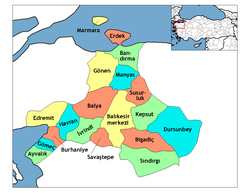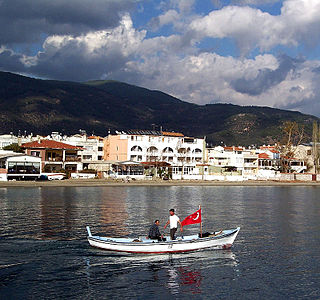
Edremit is a municipality and district of Balıkesir Province, Turkey. Its area is 682 km2, and its population is 167,901 (2022).

Balıkesir Province is a province in northwestern Turkey with coastlines on both the Sea of Marmara and the Aegean. Its adjacent provinces are Çanakkale to the west, İzmir to the southwest, Manisa to the south, Kütahya to the southeast, and Bursa to the east. The provincial capital is Balıkesir. Most of the province lies in the Marmara Region except the southern parts of Bigadiç Edremit, Kepsut, İvrindi, Savaştepe and Sındırgı districts and ones of Ayvalık, Burhaniye, Dursunbey, Gömeç and Havran, that bound the Aegean Region. Kaz Dağı, known also as Mount Ida, is located in this province. Balıkesir province is famous for its olives, thermal spas, and clean beaches, making it an important tourist destination. The province also hosts immense deposits of kaolinite and borax, with some open-pit mines. The Kaz mountains are also threatened with the expansion of gold mining using cyanide which puts the villagers' lives, the agricultural economy, and tourism at risk.
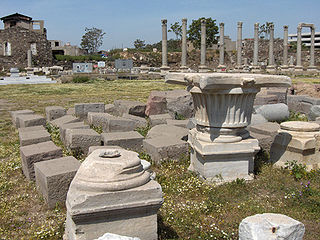
Aeolis, or Aeolia, was an area that comprised the west and northwestern region of Asia Minor, mostly along the coast, and also several offshore islands, where the Aeolian Greek city-states were located. Aeolis incorporated the southern parts of Mysia, and is bounded by it to the north, Ionia to the south, and Lydia to the east.

Pisidia was a region of ancient Asia Minor located north of Pamphylia, northeast of Lycia, west of Isauria and Cilicia, and south of Phrygia, corresponding roughly to the modern-day province of Antalya in Turkey. Among Pisidia's settlements were Antioch(ia) in Pisidia, Termessos, Cremna, Sagalassos, Etenna, Neapolis, Selge, Tyriacum, Laodiceia Katakekaumene, Adada (Pisidia) and Philomelium.
Palaeopolis (in Asia) was a city in ancient Lydia that was included in the late Roman province of Asia Prima. Its bishopric was thus a suffragan of Ephesus, the metropolitan see of that province.
Sidyma, was a town of ancient Lycia, at what is now the small village of Dudurga Asari in Muğla Province, Turkey. It lies on the southern slope of Mount Cragus, to the north-west of the mouth of the Xanthus.

The Library of Pergamum is an ancient Greek building in Pergamon, Anatolia, today located nearby the modern town of Bergama, in the İzmir Province of western Turkey. It was one of the most important libraries in the ancient world.
Aureliopolis in Lydia is a city in the Roman province of Lydia, previously called Tmolus or in Greek Τμῶλος (Tmolos). It issued coinage under each of these names, and one coin combines both names. In the Synecdemus it appears as Auliou Kome. The name "Aureliopolis" was given in honour of the emperor Marcus Aurelius.
Havran Dam is a dam in the agricultural province of Balıkesir, Turkey. The development was backed by the Turkish State Hydraulic Works. A large cave located in the dam reservoir was home to 15–20,000 bats, making it the second largest such colony in the country. Because these creatures are important to the local agriculture, the pumping operation for the dam was delayed until April, 2008 when the bats ended their hibernation.
Madra Mountains are in western Anatolia, Aegean Region of Turkey. They are horst type geological formation. The highest point of the mountains is Maya Hill.
Dionysiopolis or Dionysopolis, was a city of Phrygia in Asia Minor. The demonym Dionysopolitae (Διονυσοπολείτης) occurs on medals, and in a letter of M. Cicero to his brother Quintus, in which he speaks of the people of Dionysopolis being very hostile to Quintus, which must have been for something that Quintus did during his praetorship of Asia. Pliny places the Dionysopolitae in the conventus of Apamea, which is all the ancient writers note of their position. We may infer from the coin that the place was on the Maeander, or near it. Stephanus of Byzantium says that it was founded by Attalus and Eumenes. Stephanus mentions another Dionysopolis in Pontus, originally called Cruni, and he quotes two verses of Scymnus about it; however, the town of Dionysupolis in Thrace but on the Pontus, rather than in Pontus could be meant.
Argiza was a Greek town located in ancient Mysia and later in the Byzantine province of Hellespontus. On the Tabula Peutingeriana it is spelled Argesis and placed between Pergamum and Cyzicus. Pliny the Elder notes the town as Erizii and in his day it belonged to the conventus of Adramyttium. In later times it was Christianized and became a bishopric. No longer a residential see, it was restored under the name Algiza by the Roman Catholic Church as a titular see.
Colonia or Koloneia, also called Colonia in Armenia to distinguish it from other towns of the same name, was a town of ancient Lesser Armenia, inhabited during Hellenistic, Roman, and Byzantine times. It became important enough to be the seat of a bishop, a suffragan in the Late Roman Province of Armenia Prima, but faded like most in Asia Minor. No longer a residential bishopric, it remains, under the name Colonia in Armenia, a titular see of the Roman Catholic Church.
Briula or Brioula was an ancient city and bishopric of ancient Lydia or of Caria in Asia Minor, which remains a Latin Catholic titular see.
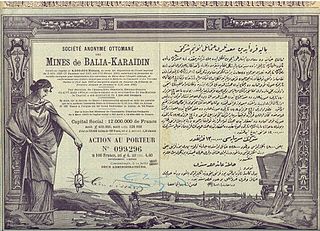
The Ilıca–Palamutluk Railway Line was a 28-kilometre (17 mi) narrow gauge railway route in Balıkesir Province, western Turkey that operated from 1924 until 1950. The line was built to transport galena lead ore that had been mined far to the east at Balya. The galena ore from Balya was transported to Palamutluk, a site at the base of the Aegean coast foothills, on an existing smaller-gauge line. The Ilıca–Palamutluk Line then took the ore onwards from Palamutluk via Edremit to a wharf at Ilıca on the Aegean coast.

Mostene (Μοστήνη), also called Mosteni or Mostenoi (Μοστηνοί), or Mostina (Μόστινα), or Mustene or Moustene (Μουστήνη), is a Roman and Byzantine era city in the Hyrcanian plain of ancient Lydia. The town minted its own coin of which many examples exist today. In 17 CE the city was hit by an earthquake and was assisted with relief from Tiberius.
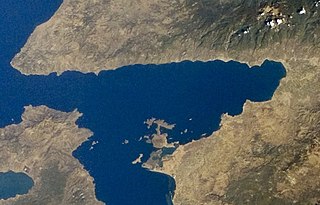
The Edremit gulf Turkish: Edremit körfezi Greek: Αδραμυττηνός κόλπος, romanized: Adramyttinós kólpos is an Aegean gulf in Turkey's Balıkesir Province. It is named after Edremit, an ilçe (district) of Balıkesir Province which is situated close to the tip of the gulf at 39°34′N26°56′E. Biga Peninsula is to the north. The southern coast belongs to the ilçe of Ayvalık, while the western entrance is enclosed with the northern part of the Greek island of Lesbos.
Claneus or Klaneos or Klaneous was an ancient city and bishopric in Asia Minor.

Isinda was a town of ancient Pisidia.
Pionia or Pioniai (Πιονίαι) was a town in the interior of ancient Mysia, on the river Satnioeis, to the northwest of Antandrus, and to the northeast of Gargara. Under the Roman dominion it belonged to the jurisdiction of Adramyttium, and in the ecclesiastical notices it appears as a bishopric of the Hellespontine province. The bishop Aetius represented the city at the Council of Ephesus. No longer the seat of a residential bishop, it remains a titular see of the Roman Catholic Church.
